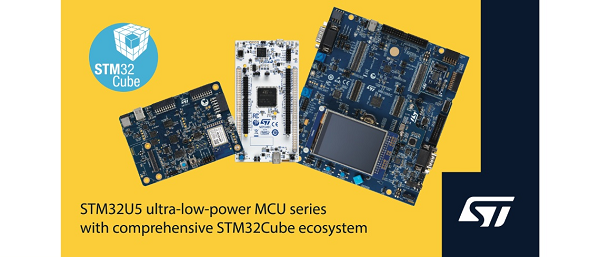
The STM32U5 is now available for purchase in the form of the STM32U575 and STM32U585. To ensure engineers can start working on their applications immediately, ST updated the STM32Cube ecosystem. Most notably, STM32CubeU5 is the first low-level MCU package to support Azure RTOS by default. It is, therefore, the symbolic child of the collaboration between ST and Microsoft that we covered last December. The software tool also differentiates itself from competing solutions by offering a myriad of Azure RTOS middleware and application example. Additionally, those who wish to use another real-time operating system can download a repository on GitHub that includes support for other platforms. Finally, developers working with STM32CubeMX can download all relevant packages directly from its user interface to simplify their workflow.
STM32U575 and STM32U585: A New Benchmark in Efficiency and Security
The STM32U5 first sampled last February. At the time, Twilio, a new ST Authorized Partner, used it to announce a new platform that vastly simplified developments. Indeed, the device enabled far greater performance while keeping a similar power consumption level. Additionally, transitioning from an STM32L5 to an STM32U5 was straightforward, which reduced our partner’s time to market. After today’s announcement, more engineers will be able to use the extra power to create simple user interfaces, which just wasn’t possible before on such a power envelope. Moreover, the STM32U5 is our first MCU to receive PSA Certified and SESIP Level 3 certifications. Put simply, the new MCU has greater hardware and software security features that protect makers and users. Hence, manufacturers can more easily attain the higher levels of accreditation necessary for specific markets, such as medical, industrial, or others.
STM32U575 and STM32U585: A New Low-Power Mode and Three New Development Boards
The updates to STM32CubeU5 and the availability of the STM32U575 and STM32U585 mean that certain features are now more accessible. For instance, example code shows how to take advantage of the low-power background autonomous mode. LPBAM allows peripherals to remain functional and use direct memory access (DMA) without waking the CPU, thus making the various stop modes even more helpful for developers. Consequently, engineers can perform sensor monitoring operations using LPBAM through I2C, SPI, or UART. Similarly, teams can perform voltage monitoring through the analog-to-digital converter, or voice activity detection by processing signals using the audio digital filter. Interestingly, a future update to STM32CubeMX will bring a graphical interface that further improve the feature’s ease-of-use.

To get started, teams can already grab the NUCLEO-U575ZI-Q. Engineers can use it with sensors and communication boards to build applications. Moreover, in the coming weeks, two more development boards will hit the shelves. The STM32U575I-EV evaluation kit comes with a camera module, sensors, and a display, to prototype more powerful IoT applications. On the other hand, the B-U585I-IOT02A comes with an STSAFE-A110 secure element and a Wi-Fi 4 module to focus on cloud applications. As a result, the latter platform has more MEMS and a port for the camera module. However, the daughterboard with the CMOS image sensor itself is sold separately.
Click Link: https://blog.st.com/stm32u575-stm32u585/






